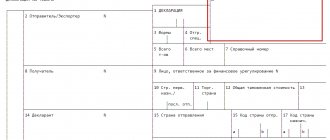Declaration is one of the main customs procedures when registering goods and cargo transported across the border; without a customs declaration for the transported product, which is completed in accordance with all the rules, it cannot be released for sale. Registration of a customs declaration is necessary to inform customs about what kind of goods were transported across the border, as well as to confirm the legality of transporting these goods.
The specified information about the goods must necessarily correspond to the actual data; when inspecting the cargo, the customs officer checks the data in the TD with reality, this is necessary to confirm the characteristics of the cargo, their safety, and the fact that they are allowed for transportation, as well as to form amounts of customs duties.
Customs authorities supervise not only the accuracy of the data specified in the customs declaration, but also the correctness of its completion.
But sometimes it may happen that when filling out the customs declaration, incorrect, unnecessary information was indicated, or any errors were made, then the customs declaration will need to be changed. This procedure, like the registration of TD itself, has a number of features and its own rules, and in order to avoid complications and bureaucratic red tape, it is best to entrust the registration and making adjustments to experienced experts. Specialists will undertake filling out the TD, as well as carrying out the procedure for making changes and additional information stated in the permit document for the entry/release of goods.
Declaring goods: why do you need a declaration?
This is a document that is filled out in cases where goods or cargo crosses the border of the Russian Federation at the entrance or exit from the state. Declaration of any cargo is carried out directly in the customs control zone; during the process, the declarant submits an application drawn up in the form established by law.
It contains accurate data about the goods being transported, the customs procedures applied to them, the transport on which they are transported, as well as other information required to authorize the carriage of goods on the basis of Art. 4 of the TC TC, can be submitted electronically remotely or in writing.
The declarant carries out the preparation and submission of the declaration, payment of all required payments and provision of the transported cargo for inspection at the request of customs. During the inspection process, a customs officer inspects the presented goods and vehicles, checks the documents and information specified in them with what the declarant presented.
The customs declaration has a form strictly established by law; a common carrier or even the owner of the cargo is not always aware of all the subtleties of its registration, the established format and other nuances.
Therefore, when filling it out on your own, errors or inaccuracies may often be made, unnecessary information may be entered, or there may be a lack of information, as a result of which you subsequently have to make changes to the TD. Specialists will help you make changes or adjustments, as well as fully take over the responsibilities for completing the customs declaration if necessary.
Definition of a customs declaration
Definition 1
A customs declaration is a document issued for goods or services transported across the customs border of a country.
This type of legal document is used for both import and export needs. As a rule, the declaration is drawn up by the person disposing of the cargo. Next, it is certified by a customs inspector, which is a kind of permission to transport cargo across the country’s border. The document contains data about the cargo, its value, method of transportation, as well as information about the sender and recipient. In the absence of a declaration, customs state control has the right to refuse to accept goods and transport them across the customs border.
Are you an expert in this subject area? We invite you to become the author of the Directory Working Conditions
Another function of the declaration can be called its declarative nature. It confirms the legality of the transaction between participants in foreign economic activity. That is, the declaration indicates that the relations between the entities comply with the requirements of the customs legislation of the country whose border the cargo will cross. Therefore, the information indicated in the declaration must fully comply with the requirements imposed by the control. If there are certain discrepancies in the document with the current system, the goods may be delayed at the border, and the documentation may also need to be reissued.
Note 1
Thus, a customs declaration is a document covering information about the cargo, the carrier, the value of the cargo, the seller and the buyer. It confirms the legality of the import or export of goods across the customs border of the country. After passing all the necessary procedures at customs, the declaration takes the form of an international “passport” of the supplied products. It acquires legal force for foreign states and their respective services.
Finished works on a similar topic
Course work The procedure for revocation of a customs declaration 480 ₽ Abstract The procedure for revocation of a customs declaration 250 ₽ Test work The procedure for revocation of a customs declaration 240 ₽
Receive completed work or specialist advice on your educational project Find out the cost
What must be indicated in the TD
All information in the TD must clearly reflect reality, the information in it is reflected as accurately and truthfully as possible, since otherwise, if inconsistencies, inconsistencies and false data are identified, the paperwork will be delayed, the cargo will be idle at customs, which can revoke the already issued TD. The information indicated in the declaration is regulated by Art. 181 TK TS:
- mode applied to the cargo;
- information about the declarant or his representative;
- information about who sent the cargo and who should receive it;
- information about the transport transporting the cargo;
- information about the goods being transported and their manufacturer;
- data on fees and payments, how they were calculated;
- information about the terms of the foreign trade transaction;
- other information.
The documents attached to the TD must also be listed; the information in the application may be supplemented and may differ depending on the type of cargo being transported, the type of customs procedure, and other nuances. It should be noted that when filling out a document, you cannot allow corrections that have not been certified by the seal of the organization declaring the cargo; in this case, the TD simply will not be accepted.
Five reasons why the declaration will be canceled
1. the director admitted that he does not participate in the activities of the organization, did not submit a declaration, did not issue a power of attorney to submit reports;
2. the manager was disqualified;
3. the declaration was submitted by a company or entrepreneur that has already been excluded from the register;
4. the director is incompetent, died or the court declared him missing;
5. The director is in prison.
Cancellation of reports is done with the approval of the Federal Tax Service. When the reporting is cancelled, it will be transferred to the “Register of Declarations Not Subject to Processing”. Upon completion of the cancellation, a special program will automatically generate a notification. This is a new form of document; previously such a notification did not exist, and respected tax authorities worked without it. This document should be sent to you within 5 working days.
Change of TD before cargo release
The information specified in the TD is supported by documents; these can be either original documents or their copies certified by a notary. Amendments to the declaration are made in accordance with established rules. This opportunity is provided both before release and after the goods have been released, for example, if the details of the transaction agreement, the name of the code of the country from which the goods were sent or the country of destination, transport document data, and a number of other information were incorrectly indicated.
Filling out customs declarations on your own may be associated with a large number of errors due to lack of experience in customs declarations, or due to lack of time.
The declarant may change or supplement the specified information if:
- he submitted a corresponding application, and the customs gave consent;
- Customs representatives themselves demanded that they be included.
In accordance with Art. 112 and 114 of the Customs Code of the Customs Union (EAEU), changing or supplementing information that is already included in the completed customs declaration before the release/admission of goods is permitted in accordance with customs permission:
- after the declarant’s request to enter changed or additional information into the TD;
- if it is necessary to clarify or supplement information that was unknown to the declarant during the preliminary customs declaration procedure.
If the TD adjustment has been submitted in accordance with all the rules, the customs representative registers it, assigns it a registration number and puts marks both in the declaration itself and in its adjustment (CDT) in paper form, registration is carried out no later than the release date of the goods. The form of adjustment, namely making changes to the customs declaration, regulated by the decision of the EAEU commission.
Review or change?
If the declarant finds erroneous data in the submitted document, he does not need to carry out the procedure for revoking the customs declaration. It is enough to make changes (make corrections), as Art. 191 of the Customs Code.
The main thing is that these changes are made before the release of goods and cannot influence the decision to release them. If the customs inspection has already begun (or the declarant has been officially notified about it), nothing can be done until it is completed.
Material for subscribers of the publication “EZh-Accountant (Accounting Supplement)”. To subscribe to the electronic version of the publication, follow the link.
Adjustment of TD after product release
Changes are permitted in a number of cases and in a certain manner, which are regulated by decision of the CU (EAEU) Commission No. 255. According to this decision, the adjustment is carried out after receiving permission from customs, which is accepted after customs control or on the basis of a reasoned application from the declarant, as well as customs itself.
The decision to adjust the TD after the release of goods is made if:
- a deficiency or discrepancy between the information specified in the TD and the information that should be there according to the approved instructions has been identified or identified;
- consideration of complaints against customs decisions, its actions or inactions is required, the procedure takes place in accordance with the legislation of the Russian Federation;
- changes or additions are necessary to the columns that are filled in by the official representative;
- The court decision on the need to make adjustments to the TD came into force.
Features of the TD adjustment procedure
In all cases, changes and additions should not affect the decision to release goods across the border, and also not lead to the need to recalculate the amounts of payments previously calculated for payment. An exception in this case is the adjustment of the customs value of goods.
Before the release of goods, information can be changed or supplemented with the permission of customs on the basis of a reasoned written application of the declarant, while simultaneously complying with the conditions established by clause 1 of Article 191 of the Customs Code.
In matters of customs declaration, it is much more profitable to seek help from professionals than to try to independently take into account the huge variety of legal and bureaucratic nuances.
It should be noted that changes to the TD before the release of goods are possible if, before receiving permission from the authorized representative of the inspection body, the declarant did not receive notification of the place and time of the inspection, and no decisions were made to conduct other control operations for inspection. transported goods.
In addition, you cannot change or enter additional data about goods that differ from those already available in the completed application, that is, you cannot change the technical description, quality, purpose of the products, which are reflected in the submitted TD.
An application for amendments to the TD is submitted by the declarant in writing in free form, indicating the registration number of the declaration, a list of data that he will change or enter additionally. The application must be accompanied by a completed TD, a copy of it in electronic form, as well as documents that confirm all adjustments in the document. If the declaration was submitted in electronic format, then the documents in the case will be taken from information resources in accordance with the established procedure.
Deadlines for possible revocation of customs declaration
The declarant does not have the right to send a request for revocation at any time. There are product statuses allowed for this, but sometimes it is too late for such an action.
Revocation of customs declaration when exporting goods
If goods are exported from the country, you can withdraw the declaration:
- while the declaration lasts;
- after the customs decision on release is made.
You can submit a recall request as long as the goods have not actually left the customs territory.
IMPORTANT! In such an application, it is required to indicate exactly where the declared goods are currently located. It is advisable to indicate the reason, but not required. It is even possible to simply change the declarant’s decision regarding the export of goods.
In the electronic declaration form, only documents in the following statuses are allowed to be recalled:
- “the declaration has been registered”;
- “declaration under verification”;
- “The decision on the goods has been made.”
If a document is submitted using remote declaration technology, then a review is also allowed with the status “Goods provided.”
When to file a new declaration is up to the declarant; the law does not limit him in terms of time.
Revocation of customs declaration when importing goods
If goods are imported into the country, the customs declaration can be recalled only before customs makes a decision on their release; accordingly, the status of the cargo in the electronic declaration can be anything other than “Inspection of goods.”
Goods under a revoked declaration are placed in temporary storage for up to 2 months. If you do not submit a new declaration within this period, they will be detained by customs.
Our services
The customs declaration must be completed in a clearly established manner, it is filled out by the declarant or his representative, it indicates only reliable, clear data on the transported goods that are moving across the border. But in some cases, errors are possible due to ignorance of the registration form, lack of experience and knowledge, lack of understanding of the declarant about what information needs to be entered in which column, and errors may also occur due to inattention or due to excitement.
To avoid all these bureaucratic delays, wasting time and nerves on filling out documents, making changes and additions to the declaration in accordance with the procedure established by law, it is best to seek help from professionals. Specialists will deal with the preparation of customs declarations, as well as changes and additions to the information specified in it, if necessary, in accordance with all the rules and in accordance with the established procedure for carrying out all procedures.
How will they prove
To revoke a declaration, it is necessary to prove that one of the grounds mentioned above exists. To do this, inspectorates must select taxpayers whose reports are suspicious . And then carry out control measures against them.
The letter lists a fairly large list of signs that may indicate that declarations are signed by unidentified or unauthorized persons. Many of these signs are well known:
- zero reporting for several periods;
- exceeding the safe percentage of VAT deductions;
- cash withdrawal;
- income equals expenses;
- frequent migrations between tax authorities;
- not being at the place of registration;
- inaccurate information in the register;
- lack of staff;
- lack of a lease agreement;
- violations related to accounts - transit transfers, a large number or, conversely, absence of accounts, location of banks in other regions;
- suspicious behavior of the manager - working without wages, living outside the place of registration or even in another region, failure to appear for questioning.
What’s new: tax authorities should be suspicious primarily of organizations registered in 2021 and later. Another suspicious fact is that the director or individual entrepreneur comes for questioning with a lawyer.
Each of these signs separately cannot be regarded as independent evidence of the mentioned violations. However, if there are several such signs, tax authorities may classify a business entity as one-day. However, the letter does not indicate exactly how many signs a suspicious taxpayer should have.





